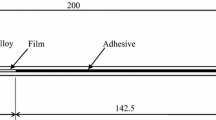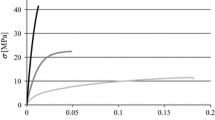Abstract
Bonded joint specimens were fabricated from composite adherends and either an epoxy or a urethane adhesive. In mixed-mode fracture experiments, the epoxy bonded specimens generally failed by subinterfacial fracture in the composite, while specimens bonded with urethane failed very close to the adhesive/substrate interface. For the epoxy bonded specimens, fracture toughness did not change significantly with mode-mix, but for urethane bonded joints, fracture toughness increased with increasing shear load. Finite element analysis, which modeled specimens bonded with the two adhesives, showed similar trends. The different toughening behaviors for the two bonded joints can be attributed to dissipation of energy through inelastic deformation, which was insignificant in the epoxy-bonded joints but substantial when the urethane was used as the bonding agent.
Similar content being viewed by others
References
Arcan, M., Hashin, Z. and Voloshin, A. (1978). A method to produce uniform plane-stress states with applications to fiber-reinforced material. Experimental Mechanics 18, 141–145.
Fernlund, G. and Spelt, J.K. (1994). Mixed-mode fracture characterization of adhesive joints. Composites Science and Technology 50, 441–449.
Hutchinson, J.W., Mear, M.E. and Rice, J.R. (1987). Crack paralleling an interface between dissimilar materials. Journal of Applied Mechanics 54, 828–832.
Hutchinson, J.W. and Suo, Z. (1992). Mixed-mode cracking in layered materials. Advances in Applied Mechanics 29, 63–199.
Johnson, W.S. and Mangalgiri, P.D. (1987), in Toughened Composites, ASTM STP 937, 295–315. N.J. Johnston, editor, American Society for Testing and Materials, 86–110.
Liang, Y.-M. and Liechti, K.M. (1996). On the large deformation and localization behavior of an epoxy resin under multiaxial stress states. International Journal of Solids and Structures 32, 1479–1500.
Ma, F., Deng, X., Sutton, M.A. and Newman, J.C. (1999). CTOD-based mixed-mode fracture criterion, in Mixedmode Crack Behavior, ASTM STP 1359, (Edited by M.P. Miller and D.L. McDowel), American Society for Testing and Materials, 86–110.
Naghdi, P.M. (1990). On the current state of finite deformation plasticity. Journal of Applied Mathematics and Physics (ZAMP) 41, 315–394.
Pagano, N.J. and Halpin, J.C. (1968). Influence of end constraint in the testing of anisotropic bodies. Journal of Composite Materials 2, 18–31.
Popelar, C.F. (1997). Ph.D. Thesis, The University of Texas at Austin.
Popelar, C.F. and Liechti, K.M. (1997). Multiaxial Nonlinear viscoelastic characterization and modeling of a structural adhesive. Journal of Engineering Materials and Technology 119, 205–210.
Suo, Z. (1990). Singularities, interfaces and cracks in dissimilar anisotropic media. Proceedings of the Royal Society of London A247, 331–359.
Swadener, J.G. and Liechti, K.M. (1998). Asymmetric shielding mechanisms in the mixed-mode fracture of a glass/epoxy interface. Journal of Applied Mechanics 65, 25–29.
Tvergaard, V. and Hutchinson, J.W. (1992). The relation between crack growth resistance and fracture process parameters in elastic-plastic solids. Journal of the Mechanics and Physics of Solids 40, 1377–1397.
Tvergaard, V. and Hutchinson, J.W. (1993). The influence of plasticity on mixed-mode interface toughness. Journal of the Mechanics and Physics of Solids 41, 1119–1135.
Voloshin, A. and Arcan, M. (1980). Failure of unidirectional fiber-reinforced materials – new methodology and results. Experimental Mechanics 20, 280–284.
Williams, M.L. (1959). The stress around a fault or crack in dissimilar media. Bulletin of the Seismological Society of America 49, 199–204.
Author information
Authors and Affiliations
Rights and permissions
About this article
Cite this article
Swadener, J., Liechti, K. & Liang, YM. Shear induced toughening in bonded joints: experiments and analysis. International Journal of Fracture 114, 113–132 (2002). https://doi.org/10.1023/A:1015013618976
Issue Date:
DOI: https://doi.org/10.1023/A:1015013618976




